The waterproofing of basement walls may not sound particularly interesting, however, most houses across America (and probably the World) have leaky basement walls. How to prevent this through proper architectural design, detailing and construction administration is the subject of this article.
Belt & Suspenders Approach
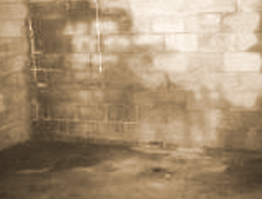
Rand Soellner, AIA of the HOME ARCHITECTS (R) typically details and specifies what he calls a “belt & suspenders” approach, meaning that his company doesn’t trust any one component in the entire system to function perfectly.
By incorporating multiple layers and multiple drainage systems, his company has successfully designed and detailed basement wall waterproofing systems that effectively keep his company’s clients’ basement walls dry and well-drained.
If you walk into a basement and smell something earthy and like mildew, that is likely to be mold growing in the damp areas of that space. Mold is just about everywhere on Earth, including in the air we breathe and in the ground. Given enough dampness, it will grow; it is that simple. So, you have to prevent water from entering your basement in order to prevent mold from growing there.
Rand Soellner has actually heard some contractors saying things like: “Hey, this house isn’t in a flood plain, so we don’t need any waterproofing around the basement walls.” What an odd thing to say. Why? Every time it rains, water drains down through soil particles. And down. And down. Next to a house, this water will naturally drain down, all along the basement wall. If there is no waterproofing along the basement walls, water will exert hydrostatic pressure against the exterior face of the basement wall.
Why Basements Leak
And what are basement walls made of ? Typically concrete or concrete block. And what typically goes into the mix to make these concrete materials? Besides all the sand, cement and aggregate, how about a lot of water? And in the spaces that hold that water, what do you suppose happens when the concrete and concrete blocks dry? You guessed it: little tiny PORES exist where the water evaporated, ALL through the concrete and concrete block. This is why normal concrete and concrete blocks are POROUS. Because they have pores that are formed inside them are part of the curing process.
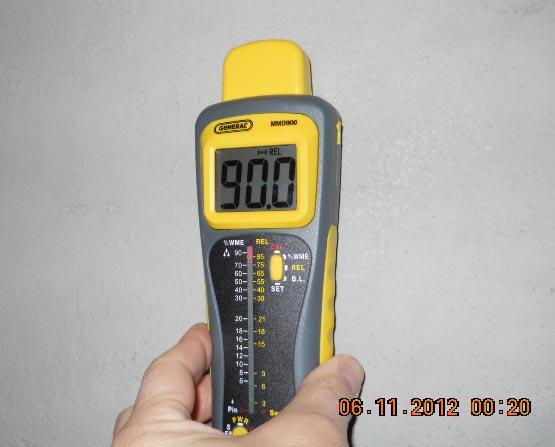
If you have never done this, the next time you happen to have a bottle of water and are near some concrete blocks or a concrete surface, pour some water over a horizontal portion of the concrete material. This works especially well if you do this to a concrete block turned sideways. What you will see is that in several seconds, the water will begin to work its way through the concrete pours until it finally comes out the other side.
Sound familiar? This is exactly what happens to your basement walls without waterproofing, or with inadequate “dampproofing.” You are trying to turn your house into a submarine when you build a basement wall. That’s a daunting task. To allow your builder to cheap out and use a cheap asphalt coating “tar” is just not up to the task.
Tar (or asphalt), has a radical molecule that unfortunately bonds with water over time and it becomes brittle with age. When it becomes brittle, it cracks. When it cracks, it allows water through and into the concrete substrate which is porous. When water gets into the concrete or concrete block, it will eventually work its way into your basement.
How This Residential Design Firm Prevents Basement Leaks
Soellner’s company has detailed dry basements in major water-prone areas as Central Florida in near-swamp conditions, mountainous regions near the sides of cliffs, the Midwest, Rockies and other challenging regions. Their approach is to use multiple waterproofing systems. That way, if there are are small failures in one system, hopefully the others will succeed in redirecting the water. Some contractors have said that they feel “comfortable” using just one system, or no waterproofing at all. Well … it’s not their house, is it? It’s yours, so you might Not be comfortable with such a cavalier attitude. You might prefer a more conservative approach that will result in a healthy, dry basement.
Basement Wall Waterproofing Techniques
So how to do it better? Use Multiple Systems. Each person and firm are responsible for their own approach and this approach has many details involved that are not discussed herein. Let’s take a look at the various Layers of one successful approach:
1. Use a Cast In Place solid Concrete Walls with steel reinforcing. Concrete block has too many joints, which can crack more easily. Also the steel reinforcing in between the blocks, particularly for horizontal reinforcing, is difficult to place properly to achieve adequate annular space of grout around the rebars to solidly embed them in a unified matrix.
2. Coat the exterior face of the wall with an Elastomeric Waterproofing as directed by
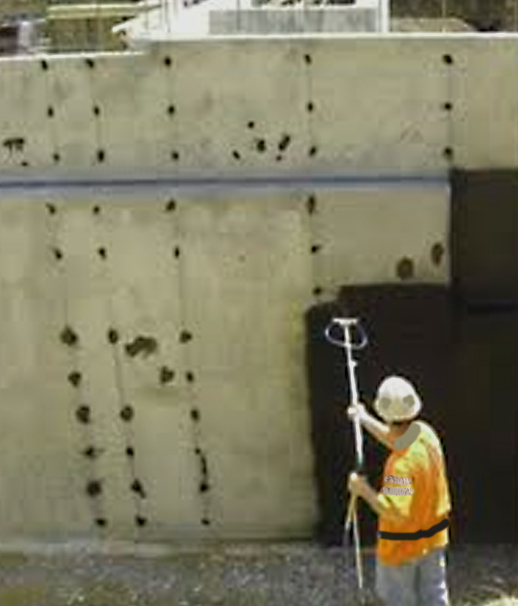
the manufacturer. You need a very clean and very dry surface. Soellner has methods to assist in this. An elastomeric waterproofing chemically engineered for subterranean conditions can typically bridge foundation wall cracks up to a certain size. Elastomerics are more like a rubberband: they can stretch and still remain intact. This is where many contractors try to economize, often at the urging of unknowing homeowners whom are trying to save a buck. This is Not the place to do that scrimping.
.
.
.
3. Next, install a Protection Board or Membrane that entirely covers the exterior
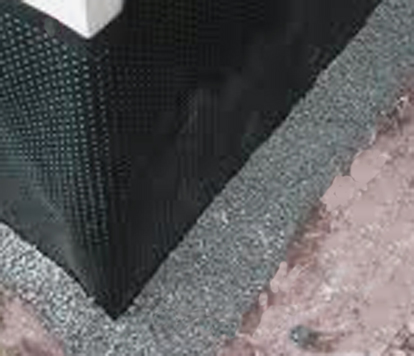
waterproofing. Why? Because sharp things, like stones, can puncture the waterproof coating and you do not want that to happen, because that can cause a leak. Also, this protection board/membrane is often dimpled, which breaks any hydrostatic pressure. You do not want any water pushing with force against your basement walls. Some manufacturers have an additional drainage system at the base of this dimpled protection sheet, which typically ends up on top of your footing, because that is where the joint occurs, due to the fact that your footing projects out from your wall.
4. Next, Rigid Insulation, if you are in a cold climate whose State Energy Code requires
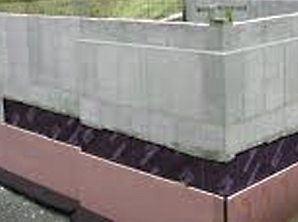
this insulation below grade. Be careful. Some insulations work better than others underground.
.
.
.
.
.
5. Think you’re done? Not quite. Next: a wide vertical layer of drainable gravel. This
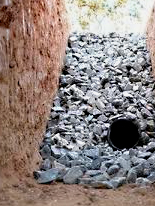
goes all the way to the bottom of the footing (not below it). And you have a drainpipe of a special type in this gravel near the bottom, and you have to protect this pipe with a special material to keep soil particles from clogging it over time. Why is this gravel and drainage here? This is the Primary Drainage Barrier for your basement wall. This is what stops the water in the soil from building pressure and allows most of it to drain harmlessly away from your home. Belt & Suspenders. If some of the water in this gravel does manage to get past it, such as in a major rainfall, then you have a backup drainage system (mentioned in item 3 above), and then if any water gets past that, then you have the actual waterproofing membrane on the wall to keep it out.
There are still some added professional details to consider. This company also makes sure that this waterproofing material continues all the way up along the foundation wall until it is capped with the metal termite flashing above, where the frame wall begins. If you have this waterproofing occurring along a sloping side wall, such as on a sloping hillside, then it would be best to provide a reglet in that portion of your foundation wall above, not receiving the waterproofing. And into this reglet, you screw metal cap flashing and sealant, to cover the top of the waterproof coating. If you do not do this, water hitting the foundation wall above the ground can get into the porous concrete wall and get behind your lower waterproofing. So this step is important.
To engage a residential architect that is familiar with this critical waterproofing, consider contacting Rand@HomeArchitects.com . 1-828-269-9046. You can reach the Contact Us page of this website at: Contact Us.
tags: custom, residential design architect, cashiers, colorado springs, telluride, aspen, jackson hole, orlando, atlanta, chicago, las vegas, timber, post and beam

1 Comment
Harald Schillinger
12:03 pm - July 2, 2012That is the best waterproofing system I have ever seen… with this system in place you will never get any water in your basement unless we have another world flood. The insulation board on the outside is interesting, but I can see where it will provide additional condensation proofing.
If everyone did this we wouldn’t have unhealthy houses, or homes.